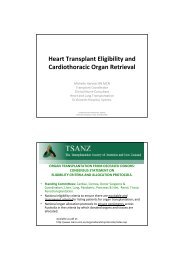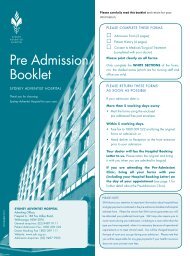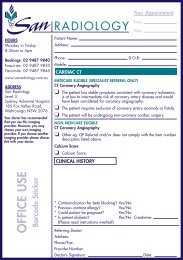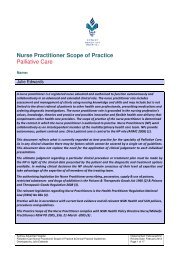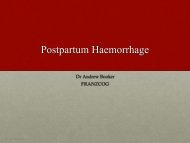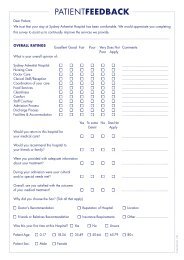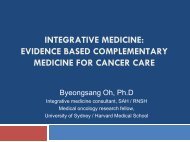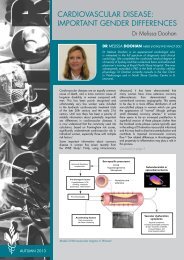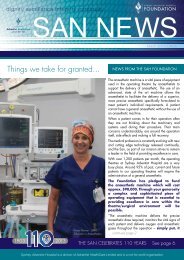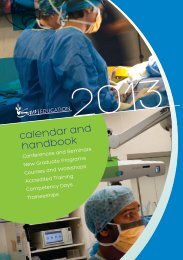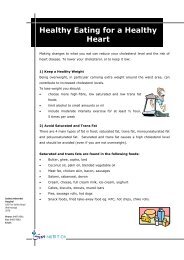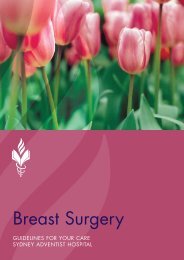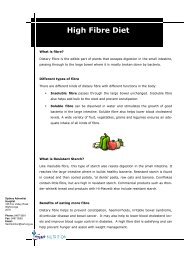Winter 2013 - Sydney Adventist Hospital
Winter 2013 - Sydney Adventist Hospital
Winter 2013 - Sydney Adventist Hospital
You also want an ePaper? Increase the reach of your titles
YUMPU automatically turns print PDFs into web optimized ePapers that Google loves.
Hip Replacement in the<br />
Younger Patient<br />
Dr Hagop Kiyork<br />
Dr HAGOP KIYORK<br />
MBBS(UNSW), FRACS (Orth), FAOA<br />
Dr Kiyork has a particular interest in surgery of the knee and<br />
hip providing joint replacement and arthroscopic surgery.<br />
Dr Kiyork practices at <strong>Sydney</strong> <strong>Adventist</strong> <strong>Hospital</strong> and Hornsby<br />
Public <strong>Hospital</strong>. P: 9979 1273 E: orthosurgery@bigpond.com<br />
W: www.orthosurgery.com.au<br />
The demand for primary total hip replacement<br />
(THR) has steadily grown with the data from the<br />
Australian Orthopaedic Association National<br />
Joint Replacement Registry (AOANJRR)<br />
confirming this trend. The number of hip<br />
replacements (primary partial, primary total and<br />
revision hip replacement) in 2011 was 39.2%<br />
higher than in 2003. 1<br />
Over the decades, THR has proved in the<br />
majority of instances to be a highly successful<br />
procedure. Many recipients attest to this fact.<br />
With an ageing population, the demand will<br />
only rise.<br />
In the early days of joint replacement surgery,<br />
THR was offered mainly to elderly, so called,<br />
low demand patients. The younger patient with<br />
an arthritic hip, or perhaps osteonecrosis, was<br />
counselled to live with their symptoms until they<br />
were “old enough” or in some cases offered<br />
an arthrodesis, a procedure now seldom seen.<br />
However, there are younger patients, under<br />
60 and some under 55 who have disabling<br />
disease of the hip joint with a desire and realistic<br />
expectations of returning to high functional levels<br />
with a THR.<br />
Many conditions can predispose the patient<br />
to early onset hip disease. These include<br />
developmental dysplasia of the hip (DDH),<br />
a history of Perthe’s disease, trauma and<br />
osteonecrosis. This is in addition to idiopathic<br />
osteoarthritis and rheumatoid disease.<br />
This group’s expectations of life differ from<br />
previous generations, and continuing with an<br />
active lifestyle is very important to many in<br />
this demographic. THR in this age group has<br />
been shown to be a successful procedure with<br />
excellent quality of life outcomes.<br />
The issue of patient age and THR is largely,<br />
but not solely, centred on the potential need<br />
for revision surgery in the ensuing years.<br />
An elderly low demand patient will likely be<br />
served for the rest of their life with a single<br />
primary THR. A young patient however (
SAN DOCTOR WINTER <strong>2013</strong><br />
CANCER GENETICS<br />
Dr HILDA HIGH BSc, MBBS (Hons), MCH, FRACP<br />
Dr Hilda High<br />
Dr High is a registered medical oncologist specialising in cancer genetics. She works at<br />
<strong>Sydney</strong> Cancer Genetics at the San Clinic having spent two years working in hereditary<br />
cancer services at the Prince of Wales, Westmead and Royal North Shore <strong>Hospital</strong>s. Dr<br />
High is the recipient of the UNSW Master of Community Health Prize after undertaking her Master in Community Health.<br />
A key member of the Cancer Institute’s eviQ group Dr High has worked with national experts to provide standardised<br />
Australian guidelines for the testing and management of inherited disorders associated with cancer.<br />
P: 9473 8833 W: www.<strong>Sydney</strong>CancerGenetics.com.au.<br />
Outline<br />
The area of cancer genetics is expanding<br />
rapidly. This article clarifies the difference<br />
between somatic and germline mutations.<br />
It also discusses genetic assessment and<br />
testing, using the Breast and Ovarian<br />
Cancer syndrome (associated with BRCA1<br />
and BRCA2 mutations) as an example.<br />
Cancer and Genetics<br />
All cancer is a genetic disease. It is<br />
caused by mistakes (mutations) in key<br />
genes involved in apoptosis, cell cycle<br />
progression, growth, differentiation and<br />
adhesion. These somatic (acquired)<br />
mutations are usually random. They<br />
occur when a dividing cell makes an error<br />
copying its DNA and they accumulate<br />
over time. Hence most cancer occurs at<br />
an older age (e.g. breast cancer occurs<br />
at an average age of 60) and is why<br />
mammographic screening programs start<br />
at 50.<br />
Knowing what somatic mutations are<br />
present in a particular tumour is important<br />
for Oncologists. It is possible to block the<br />
effect of a mutation that is driving cancer<br />
growth with a targeted therapy. A well<br />
known example is treating a breast cancer<br />
with HER2 over-expression with a HER2<br />
blocking agent such as Herceptin.<br />
Somatic mutations, while important, are<br />
not heritable. For example, the mutations<br />
that have turned a breast cell into a breast<br />
cancer have occurred in the DNA of the<br />
breast cell only. (See Figure 1). These<br />
mutations are not present in the germ cells<br />
and so cannot be passed on to offspring.<br />
Figure 1.<br />
Inherited Cancer syndromes<br />
Cancer syndromes are caused by inherited<br />
mutations in tumour suppressor genes<br />
(including DNA repair genes such as<br />
BRCA1 and BRCA2) and oncogenes. Most<br />
are autosomal dominant, in that only one<br />
faulty copy is required, either from paternal<br />
germ cells (sperm) or maternal (ovum). (See<br />
Figure 2).<br />
Figure 2.<br />
These inherited mutations are rare. They<br />
are responsible for only 2 to 10% of<br />
all cancer. However, for the individual<br />
carrying the mutation, the risk of certain<br />
cancers can be significantly increased. For<br />
example, while the average lifetime risk<br />
of breast cancer for an Australian woman<br />
is around 10%, for an Australian woman<br />
with a BRCA1 or BRCA2 mutation it is 50<br />
to 60%. For ovarian cancer the risk jumps<br />
from 1% to between 20 and 40%. 1 While<br />
these are significant increases (i.e. the<br />
“penetrance” of these syndrome is high),<br />
not every individual who carries a BRCA1<br />
or BRCA2 mutation will get cancer.<br />
Who to refer to Hereditary Cancer<br />
Services<br />
Genetic Oncologists and Hereditary<br />
Cancer Services provide specialised<br />
medical services to individuals and families<br />
affected by cancer. These services include<br />
risk assessment, genetic counselling and<br />
testing, cancer risk management and<br />
family planning information. But how to<br />
know who to refer<br />
Taking a detailed family history in a busy<br />
GP or specialist practice is not feasible.<br />
However, even brief questioning about the<br />
family history of cancer (remembering to<br />
include the paternal side) can be revealing.<br />
A rule of thumb is to refer if there are 3<br />
blood relatives with cancer, covering<br />
2 generations where ≥1 relative<br />
was diagnosed
Acute Lumbar Disc<br />
Herniation/Sciatica<br />
Dr Randolph J Gray<br />
Dr Randolph J Gray MBBS(Hons), FRACS(Orth), FAorthA<br />
Dr Gray is a fellowship trained Spinal Surgeon. He undertook training in adult and<br />
paediatric spinal surgery in Toronto, Canada. His scope of practice includes paediatric and adult spinal disorders including<br />
surgical management of paediatric scoliosis, adult degenerative and deformity, spinal trauma and tumour surgery. Dr Gray<br />
also has a special interest in minimally invasive spinal surgery (MISS). Dr Gray operates at <strong>Sydney</strong> <strong>Adventist</strong> <strong>Hospital</strong>, Royal<br />
North Shore, Westmead Childrens’ and Westmead Teaching <strong>Hospital</strong>s. P: 1300 859 500<br />
E: admin@sydneyspinespecialists.com.au W: sydneyspinespecialists.com.au<br />
Is a vegetarian diet adequate<br />
Meeting the Nutrient Reference<br />
Values on a Vegetarian Diet<br />
Carol Zeuschner<br />
CAROL ZEUSCHNER B.Ed(Sc), MAppSc(Clin Chem), PhD(Pharm)<br />
Carol Zeuschner is the Assistant Director of Corporate Services Hotel Services at the San with her role overseeing the<br />
Nutrition & Dietetics, Food Service and <strong>Hospital</strong>ity Departments. Commencing her career at the San as a Clinical Dietitian<br />
and later as Dietetics Manager, Carol has an active interest in enhancing nutritional care in hospitals. Carol has co-authored<br />
a number of review papers on vegetarian nutrition. P: 9487 9570 E: zeuschner@sah.org.au<br />
SAN DOCTOR WINTER <strong>2013</strong><br />
introduction<br />
Lumbar radiculopathy also commonly<br />
known as sciatica is a very distressing<br />
symptom. Although the aetiology changes<br />
with age the presentation can be very<br />
similar. The commonest age of presentation<br />
is 45-64 years. 1 The distribution of the<br />
follows a dermatomal pattern, which if<br />
mapped accurately allows one to make<br />
an very accurate clinical diagnosis of the<br />
compressed and irritated nerve root. (See<br />
figure 1).<br />
Lifetime prevalence of lumbar radiculopathy<br />
is reported to be 5.3% in men and 3.7%<br />
in women. 2,3 Natural history studies have<br />
shown that lumbar radiculopathy due to<br />
acute prolapsed discs resolve spontaneously<br />
in 23-48% of patients. Up to 30% will have<br />
pronounced symptoms after one year, 20%<br />
will be out of work and 5-15% will undergo<br />
surgical intervention. 4-6<br />
Figure 1.<br />
Assessment<br />
It is important to accurately map the<br />
distribution of the pain. Using this<br />
diagrammatic representation of the pain it is<br />
often possible to make a accurate diagnosis<br />
of the level of pathology.<br />
Segmental Innervation of Lower<br />
Limb Muscles<br />
L3± Knee extensors (quadriceps)<br />
L4± Ankle dorsi exors (tibialis anterior)<br />
L5±Long toe extensors (extensor hallucis<br />
longus)<br />
Observed Power<br />
Total paralysis 0<br />
Palpable or visible contraction 1<br />
Active movement, full range of motion (ROM), with gravity eliminated 2<br />
Active movement, full ROM against gravity 3<br />
Active movement, full ROM against moderate resistance 4<br />
(Normal) active movement, full ROM against full resistance 5<br />
Not testable<br />
Table 1. MRC Grading and Myotomal Innervation<br />
S1± Ankle plantar exors<br />
(gastrocnemius, soleus)<br />
A detail history of bladder and bowel habits<br />
is very important as it could be the only sign<br />
of cauda equina syndrome.<br />
A comprehensive neurological assessment is<br />
imperative. This should include a assessment<br />
myotomal power based on MRC grading<br />
(Table 1), sensation, reflexes and long tract<br />
signs. Specific tests for nerve root irritation<br />
(ie tension signs) such as a straight leg<br />
raise (SLR) and a cross leg SLR is useful in<br />
assessing the degree of nerve root irritation.<br />
Patients presenting with sciatica associated<br />
with an acute neurological deficit or<br />
bladder and bowel disturbance (ie sphincter<br />
dysfunction) are best referred to and treated<br />
in the setting of an emergency department<br />
of a hospital providing an acute spinal<br />
service. 8<br />
Investigation<br />
The investigation of choice for a patient<br />
presenting with a acute neurological<br />
symptom would be an MRI scan. A erect<br />
spinal radiograph is an useful adjunct to<br />
exclude spinal instability/deformity and for<br />
assessments of the alignment of the lumbar<br />
spine. Some of. These subtle changes may<br />
be masked on the non weight bearing<br />
supine MRI scan of the lumbar spine.<br />
Management<br />
In the absence of a neurological deficit or<br />
evidence of a cauda equina syndrome the<br />
management of lumbar ridiculous thy is<br />
essentially patient driven. The known natural<br />
history of lumbar radiculopathy would<br />
MRC<br />
Grading<br />
NT<br />
tell us that in most patients the symptoms<br />
would resolve in time. 6 Symptomatic<br />
management in the initial stage is achieved<br />
by rest, NSAID’s medication, flexion based<br />
core exercises if symptoms allow. If these<br />
measures do not relieve the pain satisfactorily<br />
then a CT guided peri neural injection<br />
of corticosteroids can be considered9.<br />
However he efficacy of this has been<br />
questioned by some researches especially<br />
corticosteroids delivered to the epidural<br />
space. 10 My anecdotal experience echoes<br />
most of the studies that are supportive of<br />
CT guided trans foraminal injections as an<br />
excellent intervention for acute sciatica. 11-14<br />
Surgical intervention is reserved for those<br />
whose pain does not improve satisfactorily<br />
in a reasonable time frame. As to how long<br />
a reasonable time frame is very variable.<br />
It depends on the response to conservative<br />
measures, severity of the residual symptoms,<br />
patients need to get back to normalcy, his or<br />
her tolerance to pain, and the aetiology of<br />
the radiculopathy. It is always important to<br />
counsel the patients that in a far majority of<br />
patients acute onset radiculopathy symptoms<br />
would settle with symptomatic treatment.<br />
Studies have shown that in the short term<br />
early surgery provides faster recovery<br />
and likely to be cost effective compared<br />
to prolonged conservative care. 15,16 Long<br />
term follow up studies have failed to show<br />
a clinical difference at 1 and 2 years in<br />
the early surgery vs prolonged conservative<br />
care groups. 5,16<br />
Cauda Equina Syndrome (CES)may present<br />
in varying combinations of lower extremity<br />
weakness, sensory loss in the lower<br />
extremities and/or saddle area, pain in the<br />
Continues on next page colour panel<br />
A vegetarian population in the US have<br />
been identified as one of the Blue Zone 1<br />
communities known for their unique health<br />
advantages, particularly longevity, and is<br />
also well known for the <strong>Adventist</strong> Health<br />
Studies (AHS) 2 on vegetarian diets. Yet<br />
scepticism remains about the nutritional<br />
adequacy of vegetarian diets for all age<br />
groups.<br />
An Australian first scientific literature review<br />
of vegetarian diets was recently conducted<br />
by a group of accredited practising dietitians,<br />
clinicians and academics with expertise in<br />
plant-based nutrition. Three staff from the<br />
<strong>Sydney</strong> <strong>Adventist</strong> <strong>Hospital</strong> were involved<br />
in the development of the series which was<br />
published in June 2012 as a supplement<br />
to the Medical Journal of Australia. It<br />
addressed key nutrients of interest including<br />
protein, iron, zinc, omega-3 and vitamin<br />
B12 in vegetarian diets. The supplement<br />
presents a balanced view of common myths,<br />
questions and misconceptions surrounding<br />
the adequacy of plant-based eating patterns.<br />
It also included a research paper referencing<br />
practical meal plans on how vegetarian diets<br />
meet the Nutrient Reference Values. 3<br />
Australia’s National Health and Medical<br />
Research Council (NHMRC) and the New<br />
Zealand Ministry of Health set the Nutrient<br />
Reference Values (NRV) as recommended<br />
target levels for all nutrients, in the form<br />
of Recommended Dietary Intake (RDI) or<br />
Adequate Intakes (AIs). Since the release<br />
in 2006 there has been some concern<br />
expressed about the ability to meet these<br />
recommendations. Compared with the 1991<br />
RDIs, the 2006 NRVs recommend a small<br />
increase in iron for men, women and pregnant<br />
women and an increase in zinc for men.<br />
For vegetarians, the further recommended<br />
increases in iron requirement (80% higher<br />
than current RDIs for non-vegetarians) and<br />
zinc requirement (50% higher than current<br />
RDIs for non-vegetarians) present additional<br />
challenges. The higher iron requirement<br />
is based on the assumption that only 10%<br />
of iron is absorbed from a vegetarian diet,<br />
compared with 18% from a mixed diet that<br />
includes meat. The higher zinc requirement is<br />
based on the fact that vegetarian diets have<br />
a higher phytate content in conjunction with<br />
evidence that the phytate-to-zinc ratio can<br />
affect zinc absorption.<br />
Sample single-day lacto-ovo vegetarian<br />
meal plans were developed to meet the<br />
NRVs including increased requirements<br />
for iron and zinc at 180% RDI and 150%<br />
RDI respectively for vegetarians across all<br />
age and gender groups. This clinical focus<br />
project shows that well planned vegetarian<br />
diets can meet almost all nutritional needs of<br />
children and adults of all ages.<br />
The meal plans met key requirements with<br />
respect to energy; protein; carbohydrate; total<br />
fat; saturated, poly- and monounsaturated<br />
fats; α linolenic acid; fibre; iron; zinc;<br />
calcium; folate; and vitamins A, C, E and<br />
B12.<br />
Vitamin D and long-chain n-3 polyunsaturated<br />
fatty acids (PUFAs) were below requirements,<br />
however these same nutrients are also a<br />
concern for non-vegetarians who have limited<br />
sun exposure and consume minimal amounts<br />
of oily fish. Small amounts of short chain n-3<br />
PUFAs (found in chia seeds, flaxseeds and<br />
walnuts) were included in the meal plans<br />
and provided significant amounts of ALA.<br />
ALA is endogenously converted to long-chain<br />
omega-3 fatty acids, but conversion depends<br />
on age, sex and dietary composition.<br />
The meal plans used minimal amounts of<br />
omega-6 fatty acids (oils and margarines) to<br />
optimise conversion.<br />
The sample meal plan for pregnant women<br />
provided 36.6mg of dietary iron, but fell short<br />
of the 48.6mg NRV for iron in pregnancy for<br />
vegetarians. The iron requirements set by the<br />
NHMRC for pregnant vegetarians exceeds<br />
the safe upper limit and did not account for<br />
the body’s adaptive absorptive mechanism<br />
or dietary enhancers of iron absorption<br />
such as vitamin C. It is common practice<br />
for pregnant women (irrespective of their<br />
dietary preferences) to take iron supplements<br />
during pregnancy or have their iron levels<br />
monitored.<br />
More Australians are now consuming<br />
regular plant-based meals in the belief that<br />
eating less meat and more plant foods<br />
improves overall health. Requirements for<br />
most key nutrients can be met across the life<br />
cycle by well planned plant-based lacto-ovo<br />
vegetarian diets. Furthermore, nutrient-dense<br />
vegetarian diets are more likely to provide<br />
additional health benefits, particularly with<br />
respect to prevention and treatment of many<br />
chronic diseases.<br />
For a more in depth discussion of the results<br />
and full references, please refer to the full<br />
paper at the MJA OPEN website. These meal<br />
plans are available to use as tools in clinical<br />
practice.<br />
References available on request.<br />
ACUTE LUMBER DISC HERNIATION/SCIATICA (Continued from page 4)<br />
low back and/or lower extremities, and visceral impairment of bladder, rectal, and/or<br />
sexual function. Patients suspected with this form of presentation should be referred to<br />
emergency department for further management. 8<br />
Surgical options<br />
Acute lumbar disc herniation (ALDHA)<br />
Far majority of patients in the age group of 45-64 present with this pain secondary to<br />
ALDH. The offending fragments can either be contained or sequestered. Once conservative<br />
measures have been exhausted a microdiscectomy is a reasonable option that would<br />
relieve most of the residual pain. 16,17 This can be performed in a minimally invasive fashion<br />
using paramedian tubular retractors or in the convention open technique through the<br />
midline. Whilst there may be some sort term benefits form the MIS technique for treatment<br />
of postero lateral LDH no long term benefits have Been demonstrated compared to the open<br />
technique. 18,19 A detail discussion of the pro and cons of each approach is beyond the<br />
scope of this article.<br />
References available upon request<br />
4 5<br />
SAN DOCTOR WINTER <strong>2013</strong>
SAN DOCTOR WINTER <strong>2013</strong><br />
DIAGNOSIS AND MANAGE-<br />
MENT OF SUBMANDIBULAR<br />
GLAND CALCULI<br />
Dr James Younessi<br />
Dr James Younessi BSc(Path) BDSc MDSc(OMFS) FDSRCS(Eng) FFDRCS(Ire)<br />
Oral Maxillofacial surgeon Dr James Younessi has a special interest in implant surgery, facial trauma management, wisdom<br />
teeth surgery, and management of benign salivary gland pathology. He operates from the <strong>Sydney</strong> <strong>Adventist</strong> <strong>Hospital</strong> and his<br />
practice is at Hornsby. Apart from his surgical craft he has a keen interest in literature and is a published author of 4 books.<br />
P: 9987 2666 E: hornsbyomfs@live.com.au W: www.dryounessi.com.au<br />
In Australia, malignant diseases of the<br />
oro-facial region are typically managed by<br />
ENT/Head and Neck surgeons.<br />
Accordingly, in this article only benign<br />
pathology of the salivary glands are<br />
considered, as appropriate to the practice<br />
of oral and maxillo-facial surgery.<br />
The salivary glands exist in two forms:<br />
• Large well encapsulated, but not<br />
necessarily well defined aggregates of<br />
cells and stroma that share a common,<br />
histologically distinct and well defined<br />
duct, viz – parotid and submandibular<br />
glands.<br />
• “Free” un-encapsulated aggregates of<br />
salivary glands known as minor salivary<br />
glands.<br />
This article covers the diagnosis and<br />
management of submandibular gland<br />
salivary calculi – but does not imply other<br />
salivary gland calculi are less important<br />
although parotid calculi are indeed less<br />
frequent.<br />
Salivary stones cause ductal obstruction,<br />
salivary stasis and therefore infection. Why<br />
they occur in the first place remains unclear,<br />
but almost certainly regular dehydration<br />
plays a part. There is, as with calculi<br />
elsewhere in the body, particular cohorts of<br />
patients who are “stone formers”. Patients<br />
with multiple calcifications should be<br />
investigated for a metabolic cause. There<br />
is a statistically significant association with<br />
hypertension and diabetes mellitus.<br />
For the benefit of my patients, I have found<br />
it easier to compare the principles of<br />
sialolithosis in roughly the same form as an<br />
oyster developing a pearl. That is, a foreign<br />
body, perhaps a food particle or pumice<br />
from tooth paste has been lodged in the<br />
salivary duct and the attempt at “warding<br />
off” this insult leads to sialolithosis.<br />
There is an interesting report of a fish bone<br />
as causative of a salivary stone. 1<br />
The potential explanation for a<br />
preponderance of submandibular<br />
Papillary<br />
stone (50%)<br />
Mouth floor stone<br />
Sublingual stone<br />
Extradochal<br />
stone (ulcerated<br />
throught wall)<br />
Figure 1. Site and approximate incidence of salivary calculi<br />
sialadenitis over the parotid or minor<br />
glands may be the more mucous nature<br />
of the saliva. Increased viscidity may<br />
mean more likelihood for stone formation.<br />
Another explanation may be the rather<br />
sharp angle the duct takes as it ascends<br />
from the gland in the neck proper to enter<br />
the mouth. Routine dehydration could lead<br />
to ready stagnation.<br />
In the above context, any person with<br />
xerostomia such as the elderly (gland<br />
involution), Sjogrën’s syndrome sufferers,<br />
diabetes mellitus, or athletes who<br />
insufficiently rehydrate themselves between<br />
bouts of sporting exertion are all at risk.<br />
Intraglandular stone<br />
ANATOMICAL SITES OF SUBMANDIBULAR CALCULI.<br />
The seminal paper by Rose describes<br />
the anatomical sites of submandibular<br />
calculi and as this is immediately relevant<br />
to management, Table 1 2 sets out these<br />
findings:<br />
As is clear from the table, stones of the<br />
ostium and the intra-orally accessible<br />
aspect of the duct account together for<br />
57% of the stones.<br />
No data exists for extra-ductal stones which<br />
are presumably eroded out of the duct. The<br />
author has seen this on only one occasion<br />
but it may have been more in keeping<br />
with earlier efforts by other colleagues at<br />
Duct opening 50% Intra-glandular 16%<br />
Mid third of duct 7% Hilar aspect 27%<br />
Table 1.<br />
Hilar stone<br />
(27%) 7cm<br />
posterior to the<br />
mandibular<br />
incisors in adults<br />
calculus removal. The local anatomy may<br />
well have been therefore perverted.<br />
Hilar and intra-glandular calculi are not<br />
accessible intra-orally and together account<br />
for 43% of the sialolithosis affecting the<br />
submandibular gland.<br />
Diagnosis is generally made clinically with<br />
pain and swelling prompting presentation.<br />
Erythema of ductal opening is not<br />
invariable. Swelling of the salivary glands<br />
and perhaps, particularly with glands<br />
being repeatedly infected, fibrosis is<br />
not uncommon. Accordingly, bi-digital<br />
examination could variably yield a swollen<br />
and painful gland in the neck (sialstasis/<br />
sialadenitis) or a small atrophic gland<br />
(fibrosis). A healthy normal submandibular<br />
gland is about the size of a walnut.<br />
Perhaps the most revealing symptom is<br />
pain and swelling on consumption of food<br />
stuffs, particularly tart foods.<br />
Clinical suspicions are generally easily<br />
confirmed when the calculus is digitally<br />
palpable and in rarer cases visually<br />
obvious. This is most commonly possible<br />
with extravasated (partial) calculi or those<br />
at the very opening of the gland duct.<br />
Clinical findings are appropriately<br />
confirmed by imaging.<br />
Asymptomatic stones have been<br />
incidentally found on otherwise routine<br />
imaging but for the purposes of this article<br />
we are concerned with confirmatory<br />
evidence of clinically suspected stones.<br />
As such a three dimensional localisation<br />
would have to be the most appropriate<br />
modality. Not only will it allow anatomical<br />
localisation and in turn assist in treatment<br />
planning but also should help exclude<br />
concurrent and perhaps more sinister<br />
pathology.<br />
Conventional sialography is probably<br />
outmoded. Cannulation of the duct in<br />
inexpert hands was not only painful<br />
but could also lead to false passages,<br />
infection/sepsis or proximal spread of<br />
the infection. Perhaps the most unpleasant<br />
consequence however was the inadvertent<br />
proximal herniation of a calculus. This<br />
would make an otherwise accessible<br />
calculus difficult to access.<br />
A CT sialogram performed expertly has<br />
perhaps only marginal benefit over a<br />
routine CT scan. Sialectasis, multiple<br />
stones, or additional pathology such as<br />
Sjögren’s syndrome is perhaps better<br />
illustrated. An MRI scan is valuable when<br />
additional pathology such as a tumour is<br />
suspected. Ultrasound is useful in depicting<br />
the gland in the neck but is of lesser value<br />
in 3D identification of the pathology and<br />
intra-oral examination of the duct is not<br />
practical.<br />
MANAGEMENT OF SALIVARY STONES.<br />
Duct:<br />
Gland/Hilum:<br />
Table 2.<br />
Management is dependant upon the<br />
anatomical location of the stone and the<br />
operator’s preference and expertise.<br />
Immediate management centres on<br />
rehydration of the patient, steroids,<br />
analgesia and antibiotics.<br />
Perversely, a tart diet or sucking on a lemon<br />
wedge as has been advocated by some<br />
authorities is inappropriate in the acutely<br />
inflamed and painful gland. Sialogogues,<br />
aperitifs or tart foods would encourage<br />
gland activity and the secretion beyond<br />
the obstructed duct can cause pain.<br />
It is preferable to consume a bland diet<br />
until the gland is less inflamed and/<br />
or the obstruction addressed. Of course<br />
thereafter sialogogues are appropriate<br />
to encourage residual gland activity and<br />
mechanical flushing.<br />
Appropriate antibiotics are those with<br />
cover for oral flora and a combination<br />
of Amoxicillin and Metronidazole is<br />
often quite appropriate. Up to 8mg of<br />
Dexamethasone or equivalent given as a<br />
once only dose is also appropriate.<br />
Definitive management often warrants<br />
surgical intervention and is tabulated in<br />
Table 2 for quick reference.<br />
Please recall that not all ductal obstructions<br />
are calcified and thus they may not be<br />
subject to imaging. Thickened saliva can<br />
often occlude a duct, particularly one with<br />
a smaller lumen, and manifest identically.<br />
Provided the stone is accessible, suction<br />
extraction may be possible. A small ductal<br />
incision may be needed.<br />
More often, though, formal dissection<br />
of the duct and gentle exploration under<br />
good lighting with meticulous haemostasis<br />
is needed. The best recommendation to<br />
assist here is the use of a “stay suture”<br />
proximal to the ductal occlusion, lest the<br />
stone be displaced further away from<br />
the sublingual (accessible) aspect of the<br />
floor of the mouth. Recall ductal dilatation<br />
and salivary pooling would make such a<br />
prospect otherwise perfectly plausible.<br />
The major impediment for ductal calculus<br />
extraction is the rich nearby vasculature<br />
and the lingual nerve as it “double<br />
crosses” the submandibular gland duct<br />
more proximally. Lingual altered sensation<br />
and partial loss of taste (chorda tympani)<br />
is possible. Here, as always informed<br />
consent is essential.<br />
Removal of stone/Meatotomy/Duchoplasty/Lithotripsy<br />
Sialoadenectomy with a cervical approach.<br />
Hilar or intra-glandular stones mandate<br />
a submandibular sialoadenectomy. An<br />
incision is made in the neck proper<br />
some 4cm below the lower border of the<br />
mandible. Keeping the dissection beneath<br />
the platysma muscle gives the operator<br />
the greatest chance of preserving the<br />
marginal mandibular branch of the VII<br />
cranial nerve. The fascia propria of the<br />
submandibular gland is utilised, and care<br />
taken to avoid nicking it. In this way, a<br />
neat bloodless field assists the procedure.<br />
The lingual nerve needs to be identified<br />
and preserved whilst the oral aspect of the<br />
duct tied as far anteriorly as practical. The<br />
clue is often the submandibular ganglion.<br />
Some authorities have suggested oral<br />
cannulation of the duct pre-operatively to<br />
assist intra-operative identification and<br />
in turn preservation of the lingual nerve<br />
which would appear very similar.<br />
A suction drain is usually used for a day or<br />
two, once the wound is repaired.<br />
Shockwave lithotripsy has not seen wide<br />
application in salivary calculi management<br />
and certainly in the early genesis of this<br />
treatment modality, shattering of nearby<br />
teeth was reported.<br />
Sialolithosis is common and the majority<br />
occur in the submandibular system. A<br />
sizeable stone or ductal irritation and<br />
fibrosis from a smaller calculus could<br />
cause complete obstruction and sepsis.<br />
Anteriorly placed ductal stones may be<br />
subject to removal intra-orally but hillar or<br />
intra-glandular stones generally warrant<br />
sialoadenectomy. Perhaps there may<br />
be a role for fibroptically assisted stone<br />
extraction for gland preservation in the<br />
future.<br />
References:<br />
1. Abe K, Higuchi T, Kubo S and Oka M (1990)<br />
Submandibular sialadenitis due to a foreign<br />
body.<br />
British Journal of Oral Maxillofacial Surgery 28:<br />
50-52<br />
2. Rose SS (1954)<br />
A clinical and radiological survey of 192 cases<br />
of recurrent swellings of the salivary glands.<br />
Annals of the Royal College of Surgeons,<br />
England 15: 374-401<br />
SAN DOCTOR WINTER <strong>2013</strong><br />
6 7
NEWLY ACCREDITED<br />
SPECIALISTS<br />
Dr Garrick Don<br />
B.Med.Sci.(Hons I), MBBS (Hons), FRACP<br />
Respiratory & Sleep Medicine,<br />
Bronchoscopy/EBUS<br />
Dr Garrick Don is a Respiratory & Sleep Physician,<br />
who has an interest in servicing the Hills, North<br />
Shore and Central Coast, with practices at <strong>Sydney</strong><br />
<strong>Adventist</strong> <strong>Hospital</strong>, Hornsby and Gosford <strong>Hospital</strong>s. His current<br />
clinical practice covers a wide range of disorders including Airway<br />
Disease (COPD, emphysema, asthma & bronchiectasis), Interstitial<br />
Lung Diseases, Lung Cancer, Tuberculosis and Sleep Medicine with<br />
an additional special interest in bronchoscopy and further advanced<br />
endoscopic sampling techniques, such as EBUS. P: 9477 7867<br />
F: 9477 1278 E: drgarrickdon@gmail.com<br />
Dr Richard L Haddad<br />
B.Med.(Newc) M.S.(Syd)(Urol) FRACS(Urol)<br />
Urological Surgeon, Robotic Uro-Oncology<br />
Dr Richard Haddad has completed dual Fellowships.<br />
He was awarded a grant to complete a Robotic<br />
Uro-Oncology Fellowship at the prestigious McGill<br />
University Health Centre, Montreal Canada. As a result, he intends<br />
to use the robotic platform for major urological surgery. He is an<br />
extensively trained open and laparoscopic urological surgeon. He<br />
has published and holds a Master of Surgery (Urology) from <strong>Sydney</strong><br />
University, in prostate cancer. P: 1300 964 463 E: drrhurol@gmail.com<br />
W: roboticurologysydney.com.au<br />
NEWS FROM<br />
THE SAN<br />
• The <strong>Sydney</strong> <strong>Adventist</strong> <strong>Hospital</strong> Education Centre will open<br />
in September this year. Providing education and simulated<br />
learning facilities for interprofessional multidisciplinary<br />
clinical training of medical, nursing and allied health<br />
professionals, the $17 million purpose-built Centre of<br />
Excellence will be home to the <strong>Sydney</strong> <strong>Adventist</strong> <strong>Hospital</strong><br />
Clinical School of The University of <strong>Sydney</strong> (SAHCS) and<br />
Avondale College Faculty of Nursing and Health. By<br />
2016, the Education Centre will deliver 37,208 training<br />
days for healthcare students and professionals.<br />
• Developing such landmark education project like<br />
the Education Centre requires vision, leadership and<br />
collaboration. Dedications of an auditorium seat or<br />
learning space in someone’s honour are welcomed<br />
and can be discussed with Assistant Director of<br />
Medical Services Catherine Murphy on 9487 9400.<br />
See www.sah.org.au for more details.<br />
• The San’s New Multi-deck car park,<br />
which is now open, offers 896 new<br />
places. The total car spots on site will be close to 1900<br />
by the end of the Redevelopment.<br />
• The $181 million Redevelopment is on target to complete<br />
by mid - 2014 and will include an extra 200 beds, a new<br />
Maternity and Women’s Health Unit, up to 12 operating<br />
theatres, an Integrated Cancer Centre and new arrivals<br />
and entrance areas. See www.sah.org.au.<br />
SAH GRAND ROUNDS (ALL GP’S INVITED)<br />
Dr Callum Gilchrist<br />
BMedSc(Hons) MBBS FANZCA<br />
Anaesthetist<br />
Dr Callum Gilchrist’s sub-specialty areas of interest<br />
are anaesthesia for ENT, dental-maxillofacial,<br />
endocrine, and general surgery, in addition to<br />
anaesthesia for interventional neuroradiology.<br />
He practices at <strong>Sydney</strong> <strong>Adventist</strong> <strong>Hospital</strong> and is the Specialised<br />
Study Unit Supervisor for head and neck, ENT, dental<br />
surgery and ECT anaesthesia at Royal North Shore <strong>Hospital</strong><br />
within the ANZCA training program. P: 02 8078 4281<br />
E: drcallumrgilchrist@gadr.com.au W: www.gadr.com.au<br />
July 24<br />
A/Prof Henry Woo Urology<br />
August 19 Dr Auriel Jameson General Medicine<br />
October 15 A/Prof Henry Woo Urology<br />
19 August Professor Sharon Kilbreath Breast cancer and<br />
exercise, lymphoedema management and<br />
prevention of shoulder impairments post<br />
mastectomy.<br />
15 October Professor Sharon Kilbreath<br />
Breast cancer and exercise, lymphoedema<br />
management and prevention of shoulder<br />
impairments post mastectomy.<br />
11 November Professor John Watson Neurology<br />
Grand Rounds are held in the Level 2 Conference Room from<br />
12.30 – 13.30pm. (Light refreshments available from 12.00pm.<br />
Please register on arrival).<br />
SAN DOCTOR WINTER <strong>2013</strong><br />
8<br />
The San’s <strong>Hospital</strong> in the Home (HITH) accepts direct<br />
GP referrals for suitable patients. Ring HITH Director<br />
Dr Suhan Baskar to discuss details of clinical eligibility<br />
and referral pathways.<br />
P: 9487 9111 E: Suhan.baskar@sah.org.au<br />
DIARY DATES<br />
GP CONFERENCES (CPD points available with proof<br />
of attendance)<br />
July 24<br />
August 21<br />
October 17<br />
men’s Health<br />
Emergency Medicine<br />
Oncology<br />
FREE PUBLIC FORUM (everyone welcome)<br />
September 10<br />
Men’s Health<br />
Dates and topics are subject to change. Contact 9487 9871<br />
to register or visit www.sah.org.au for further details.



